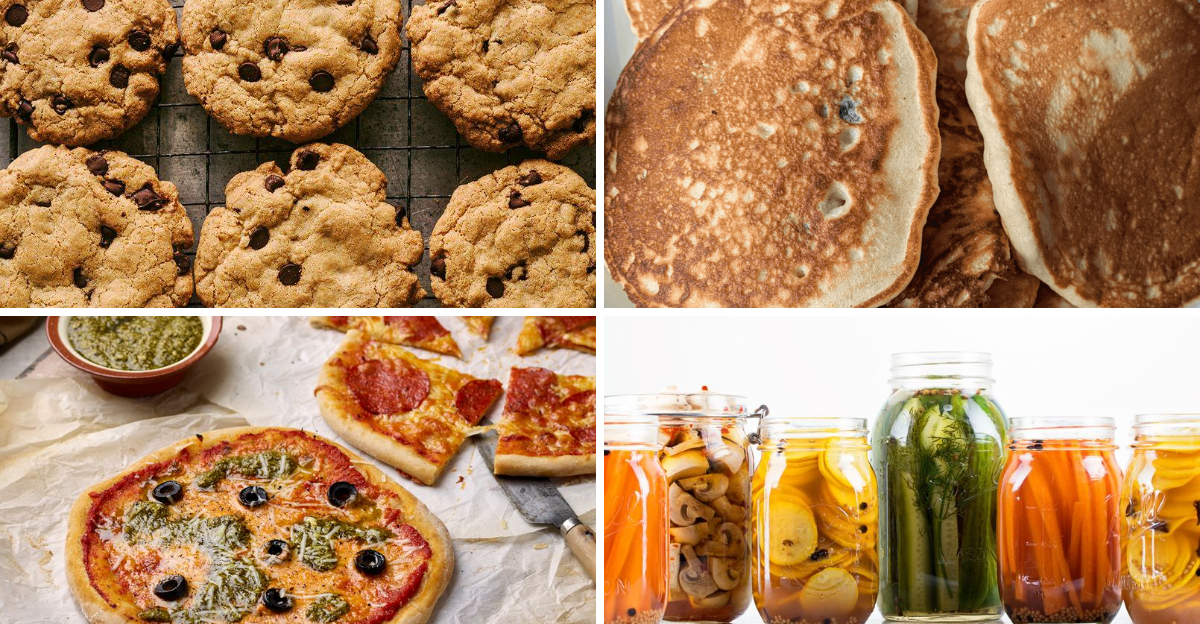15 Surprising Ways to Use Leftovers in Food

Leftovers often sit forgotten in the fridge, but they hold the key to unexpected culinary adventures. From innovative recipes to less conventional uses, these ideas will inspire you to rethink how you handle surplus food. Whether you’re looking to minimize waste or simply explore new flavors, these 15 surprising ways to use leftovers will transform how you view yesterday’s meal remnants. Let’s explore the possibilities of turning mundane leftovers into something extraordinary.
1. Pasta Crust Pizza

Leftover pasta can serve as a creative pizza crust alternative. Simply mold cooked pasta into a circle on a baking sheet, using eggs and cheese to bind it. Bake until the base begins to crisp, then add your favorite traditional pizza toppings like tomato sauce, mozzarella, and basil. This method not only reduces food waste but also introduces a diverse texture and flavor to your pizza. For those with a sweet tooth, consider a dessert version using sweetened ricotta and fruit toppings. This adaptable recipe allows you to cater to both savory and sweet cravings. It’s an inventive way to use pasta that might otherwise be discarded, offering a fun twist on a classic dish.
2. Bread Crumb Cookies

Transform stale bread into delicious cookies by grinding it into fine crumbs. Mix these breadcrumbs with sugar, butter, eggs, and chocolate chips for a delightful treat. The breadcrumbs add a distinct crunch, making for an unusual yet satisfying cookie texture. The use of stale bread not only minimizes waste but also adds an earthiness to the cookie’s flavor profile. Experiment with spices such as cinnamon or nutmeg to enhance the taste. This recipe is a fantastic way to give old bread a second life. Offering both a cost-effective and innovative approach, these cookies are sure to surprise your taste while cleverly repurposing what would otherwise be kitchen waste.
3. Rice Pancakes

Leftover rice can be transformed into fluffy pancakes that are both delicious and easy to make. Combine cooked rice with flour, eggs, milk, and a pinch of baking powder to form a batter. Fry spoonfuls of this mixture on a hot griddle until brown. These pancakes offer a delightful twist on the traditional breakfast, with a hint of chewy rice texture. Enhance the flavor by adding vanilla or cinnamon. Serve with your choice of syrup, fruit, or nuts for a wholesome meal. This recipe is a nice strategy for using up rice that might have been left over from a previous meal, making breakfast both resourceful and flavorful.
4. Veggie Broth Ice Cubes

Turn leftover vegetable scraps into flavorful broth ice cubes. Simply simmer the scraps in water, strain, and freeze the broth in ice cube trays. These cubes are excellent for quickly enhancing soups, stews, and sauces. Not only do they reduce waste, but they also provide a convenient way to add depth and flavor to your cooking. Consider incorporating herbs like thyme or bay leaves for added aroma. These broth cubes are a practical solution for preserving vegetable flavors that would typically be lost. Use them as needed to infuse dishes with a concentrated burst of taste, making them a staple in any resourceful kitchen.
5. Savory Bread Pudding

Turn day-old bread into a hearty savory bread pudding. By combining the bread with eggs, cheese, and vegetables such as spinach or mushrooms, you can make a rich, filling dish. Bake until the top is brown and the center is set. This versatile recipe can adapt to whatever leftover vegetables or proteins you have. It’s an excellent way to use up surplus bread and reduce waste. The savory bread pudding is excellent for brunch or as a side dish, offering a comforting yet sophisticated option. Experiment with different cheese varieties or spices to keep the flavors exciting. This dish is both an inventive and practical use of leftovers.
6. Fruit Salad Smoothies

Leftover fruit salad can easily be turned into a refreshing smoothie. Simply blend the fruit with yogurt or milk, and sweeten to taste with honey or agave. The smoothie can be enriched with additional ingredients like chia seeds or spinach for extra nutrition. This approach ensures none of the fruit goes to waste while offering a quick and healthy snack or breakfast option. The natural sweetness of the fruit negates the need for added sugars. Adjust the consistency by adding more liquid if needed. This method is not only resourceful but also provides a creative way to enjoy fruits in a different form, making it a go-to for leftover management.
7. Mashed Potato Waffles

Use mashed potatoes by making savory waffles. Mix them with eggs, flour, and cheese, then cook in a waffle iron until brown. These waffles are crispy on the outside and tender inside, providing a delightful alternative to traditional breakfast items. Serve them with sour cream, chives, or even a fried egg on top for added flavor. This recipe is an excellent way to prevent leftover mashed potatoes from going to waste, offering a creative twist on a familiar dish. Ideal for brunch, these waffles are sure to please those looking for something different yet comforting in their morning meal.
8. Herb-Infused Oil

Use leftover herb garnishes to make a flavorful infused oil. Combine the herbs with olive oil in a bottle and let them steep for several days. This infused oil can be used to enhance salads, pastas, or grilled dishes with a burst of aromatic flavor. It’s a simple yet effective way to utilize herbs that might otherwise be discarded. The process of infusion allows the oil to capture the essence of the herbs, offering a gourmet touch to your everyday cooking. This homemade infusion not only reduces waste but also provides a versatile ingredient for a variety of dishes, enhancing their taste and presentation.
9. Cheese Rind Soup Base

Cheese rinds can add a rich, umami flavor to soups and stews. Simmer them with your base ingredients to enhance the depth and complexity of the dish. Once the flavors have melded, remove the rinds before serving. This method maximizes the use of cheese, ensuring every bit contributes to your meal. It’s a creative way to utilize what is often discarded, transforming it into a culinary asset. Whether you’re making a vegetable soup or a hearty stew, the cheese rind adds a layer of creaminess and richness. This approach not only reduces waste but also enhances the taste of your homemade soups.
10. Leftover Omelette

An omelette is a versatile dish that can incorporate a variety of leftovers. Use vegetables, meats, or cheeses to fill your omelette, bound together with beaten eggs. This not only reduces waste but also allows for a personalized meal tailored to your tastes. Cook the mixture in a non-stick pan until the eggs are set. Fold and serve with a side salad or toast. This method encourages creativity and experimentation with flavors. It’s a simple yet effective way to make use of small amounts of leftovers that might not be sufficient for a standalone meal, making breakfast or brunch more exciting and resourceful.
11. Crispy Rice Snacks

Transform leftover rice into crunchy snacks by frying or baking it with your choice of spices. These snacks are flavorful and have a satisfying crunch. Season with salt, pepper, or a spice blend of your choice to enhance the taste. This method not only reduces food waste but also offers a diverse snack option. Ideal for on-the-go munching or as a side dish. It’s a creative way to give new life to rice that might otherwise be forgotten in the back of the fridge. Whether you prefer spicy, savory, or sweet, these crispy rice snacks can be tailored to fit any flavor profile.
12. Pickled Vegetable Stems

Vegetable stems can be pickled to make a tangy, flavorful snack. Simply cut the stems into pieces, immerse them in a mixture of lemon juice, water, salt, and spices, and let them sit for a few days. This pickling process transforms what might be considered waste into a delicious treat. It’s a method that preserves the stems and enhances their natural flavors. These pickled stems can be used as a garnish, in salads, or as a side dish. They provide a crunchy texture and a burst of flavor that complements a variety of meals. It’s an inventive way to ensure that no part of the vegetable goes unused.
13. Soup Jar Lunches

Transform leftover soup into a portable, convenient lunch by layering it in a mason jar with grains and fresh vegetables. This makes a balanced meal that’s easy to transport and consume. Customize each jar with different combinations of grains like quinoa or barley, and a variety of vegetables. It’s a practical way to utilize soup leftovers while maintaining a nutritious diet. The layering not only looks appealing but also keeps the ingredients fresh and flavorful. This concept encourages the use of leftovers in a way that’s both functional and satisfying, reducing waste while providing a complete meal solution for busy days.
14. Sweet Potato Pancake Bites

Leftover sweet potatoes can be turned into tasty pancake bites. Mix them with eggs, flour, and spices like cinnamon and nutmeg. Cook small spoonfuls on a griddle until each side is brown. These bites are ideal for breakfast or as a snack, offering a sweet and savory flavor. Top with honey, nuts, or yogurt for added texture and taste. This recipe not only makes use of sweet potatoes that might otherwise be discarded but also makes a delightful treat for any time of the day. It’s a simple yet effective way to enjoy sweet potatoes in a new form, maximizing flavor and minimizing waste.
15. Tomato Sauce Ice Pops

Transform leftover tomato sauce into savory ice pops for a surprising treat. Pour the sauce into molds, add herbs like basil or oregano, and freeze. These ice pops can be an unexpected appetizer or a palate cleanser between courses. The idea of using tomato sauce this way might seem unusual, but it offers a novel experience for adventurous eaters. This method ensures that no sauce goes to waste while making a conversation starter at gatherings. These ice pops embody a creative approach to leftovers, inviting playfulness and innovation into the kitchen. They’re a testament to how reimagining ingredients can lead to delightful culinary discoveries.
